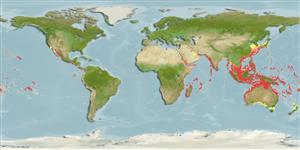Common names from other countries
Classification / Names / Names
ชื่อสามัญ | ชื่อพ้อง | Catalog of Fishes (gen., sp.) | ITIS | CoL | WoRMS
Environment: milieu / climate zone / depth range / distribution range
นิเวศวิทยา
เกี่ยวกับหินโสโครก; ระดับความลึก 0 - 133 m (Ref. 100991). Tropical
Indo-Pacific: East and South Africa to eastern Polynesia.
Length at first maturity / ขนาด / น้ำหนัก / Age
Maturity: Lm ? range ? - ? cm Max length : 9.5 cm SHL เพศผู้/กระเทย; (Ref. 349); common length : 4.0 cm SHL เพศผู้/กระเทย; (Ref. 349)
Length based on occurrence record; to be replaced with better reference. Usually found under slabs and small corals (also Ref. 799), frequently occurring in groups (Ref. 349). Also found in shallow subtidal waters (Refs. 349, 2925). Dead shells found on the beaches (Ref. 88739). Members of the family Cypraeidae are primarily carnivores (Ref. 67623).
Life cycle and mating behavior
วัยเจริญพันธุ์ | การสืบพันธุ์ | การวางไข่ | เซลสืบพันธ์ของเพศเมีย(ไข่) | ความดกของไข่ | ตัวอ่อน
Members of the order Neotaenioglossa are mostly gonochoric and broadcast spawners. Life cycle: Embryos develop into planktonic trocophore larvae and later into juvenile veligers before becoming fully grown adults.
Poutiers, J.M. 1998. (Ref. 349)
IUCN Red List Status (Ref. 130435)
CITES status (Ref. 108899)
Not Evaluated
Not Evaluated
Threat to humans
Harmless
Human uses
การประมง: การค้า
| FishSource |
เครื่องมือ
ข้อมูลเพิ่มเติม
Age/SizeการเจริญเติบโตLength-weightLength-lengthสัณฐานวิทยาตัวอ่อนอุดมสมบรูณ์
แหล่งที่มาจากอินเตอร์เน็ต
Estimates based on models
Preferred temperature
(Ref.
115969): 22.5 - 29.1, mean 28 (based on 2376 cells).
Vulnerability
Low vulnerability (10 of 100).
Price category
Unknown.
